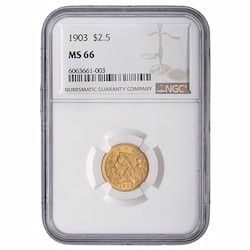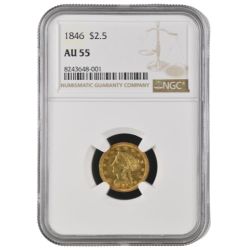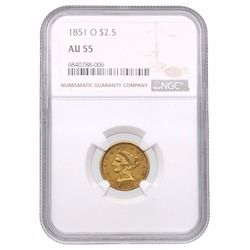$2.5 Liberty Gold Coin
The Liberty Head Quarter eagles, minted continuously from 1840 to 1907, hold a notable place in American coinage for having the longest uninterrupted production of any design without a major alteration.
For collectors and investors alike, the Liberty Head Quarter Eagle is a testament to gold coinage's enduring legacy and intrinsic value.
History and Design
The obverse of the Gold Liberty Head $2.5 coin features a left-facing portrait of Lady Liberty. She is depicted with finely detailed hair and a coronet inscribed "LIBERTY." Encircling her head are thirteen stars, representing the original thirteen colonies.
The date of mintage is placed below the portrait, completing the classic design by Christian Gobrecht, third Chief Engraver of the United States Mint.
The reverse of the Gold Liberty Head $2.5 coin showcases a heraldic eagle with outstretched wings and a shield on its chest. The eagle holds an olive branch in its right talon and a bundle of arrows in its left, symbolizing peace and readiness for war. Surrounding the eagle are the inscriptions "UNITED STATES OF AMERICA" and the denomination "2 1/2 D." The intricate design embodies the strength and resilience of the nation.
The $2.5 Liberty Head coin, or Quarter Eagle, was minted from 1840 to 1907. Production began at the Philadelphia Mint in 1840 and continued until 1907. The Charlotte Mint (C) also started in 1840, minting the series until 1860. The Dahlonega Mint (D) began production in 1840 and continued until 1859.
The New Orleans Mint (O) produced the coin from 1840 to 1857. The San Francisco Mint (S) started minting the Quarter Eagle in 1854 and continued until 1879.
Features and Variations
Although the coin did not undergo major changes throughout its production, in numismatics, every detail can affect its value.
Small Dates
In 1843, the US Mint produced two distinct varieties of quarter eagles: the Small Date and the Large Date. The names refer to the size of the mintage year on the obverse design below Lady Liberty's bust.
The 1843-O Small Date is easy to find in all circulated grades up to AU55 and only moderately scarce in AU58. It is scarcer than generally acknowledged in lower Uncirculated grades and rare in MS62. In MS63 and higher, it is a rare coin, and Gems are scarce.
The 1842-C Small Date is the rarest Charlotte Mint quarter eagle, though not the rarest date in high grade. Most often seen in Very Fine and Extremely Fine grades, it is rare in properly graded AU50 to AU55 and very rare in AU58. An estimated five or six coins are graded Uncirculated by today’s standards, with none higher than MS62.
Large Dates
The 1843-O Large Date is the second-rarest New Orleans quarter eagle overall and the third-rarest in high grades.
The 1843-C Large Date is reasonably common in lower grades, typically in the VF20 to EF40 range. It is harder to locate in AU grades than some might expect, with properly graded AU55 to AU58 coins being scarce. It is rare in Uncirculated conditions, with up to three known in MS64 and a single known Gem example.
1848 $2.50 CAL.
The tiny letters CAL. were punched into the field above the eagle to designate that these coins were minted from the first gold sent to the Philadelphia Mint from California. As a matter of fact, the 1848 CAL. Gold Quarter Eagle is the first official United States commemorative coin; around 300 survived from many years.
1859 $2.50 New Reverse
The letters are smaller and more widely spaced than issues from 1840 to 1858, with noticeably smaller arrowheads. Additionally, there are distinct differences in the shape of the claws, olive branches, and wing tips. This "new" design was used until the Liberty Head type was discontinued in 1907.
1859 $2.50 Old Reverse
in 1859, 1860, and 1861, the Philadelphia Mint still used the old reverse. The 1861 Old Reverse is approximately twice as rare as the New Reverse and, logically, more expansive.
Collectibility
In numismatics, several factors contribute to a coin's value; one is its collectible appeal, which is influenced by its historical significance, rarity, and composition.
Rarity
There were several rarities produced within the 1840 to 1907 span, notably the 1841, the 1863 issue (struck in Proof finish, to the extent of just 30 coins), the seldom-seen 1854-S (of which just 246 business strikes were made), and the low-mintage 1875.
Composition of the coin
The Liberty Head $2.5 Quarter Eagle has a diameter of 18 millimeters and weighs 4.18 grams. It is made of 90% gold and 10% copper. The price of gold coins is tied to the price of gold, and they are one of the most popular ways of acquiring gold bullion nowadays.
Investment
Gold has been used as currency since ancient times and has stood the test of time as a reliable means of preserving wealth. As an investment, gold is a popular choice for portfolio diversification. Its intrinsic value and the tendency of people to turn to gold in times of uncertainty contribute to its enduring appeal.
Gold's numerous applications in industry, healthcare, technology, and jewelry add to its stability and significant appreciation potential.
As for the Liberty Head $2.5 Gold Coin is a remarkable piece of American numismatic history. Its continuous production from 1840 to its end in 1907, without significant design alterations in the series, showcases its timeless appeal and significance.
The detailed craftsmanship on both the obverse and reverse and its historical context and variations make it a highly collectible and valuable coin. Its composition of 90% gold further enhances its desirability as a form of investment and wealth preservation.
































